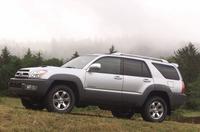2003 Toyota 4Runner SR5 Review
SEE ALSO: Toyota Buyer's Guide
THE AUTO PAGE By JOHN HEILIG
SPECIFICATIONS
MODEL: Toyota 4Runner SR5
ENGINE: 4.7-liter DOHC V8
HORSEPOWER/TORQUE: 235 hp @ 4,800 rpm/320 lb-ft @ 3,400 rpm
TRANSMISSION: 5-speed automatic
WHEELBASE: 109.8in.
LENGTH x WIDTH x HEIGHT: 189.0 x 73.8 x 68.9 in.
STICKER PRICE: $31,740
The fourth-generation Toyota 4Runner is all-new, all-powerful, and in its ads at least it gives you the impression that it can conquer Mt. Everest.
Well, we weren't able to travel to the Himalayas to check out this apparent claim, but we did drive our test 4Runner all over eastern Pennsylvania in as severe an on-road test as one can give a vehicle. And while it wasn't Everest, the 4Runner did do quite well on our favorite mountain road as well as some of our favorite straighter roads as well.
Our tester was equipped with the optional 4.7-liter double overhead cam, 32-valve V8 that delivers a healthy 235 horsepower. Our tester had a listed curb weight of 4,410 pounds, so the power was important if we wanted the 4Runner to get out of its own way. The V8 did a great job of delivering the power through a five-speed automatic transmission. We hit the hills and curves and the 4Runner seemed to ask for more every time. If anything, here was a vehicle that was happy doing everything one asked of it.
But the new 4Runner is more than just power. A 4.0-liter 245 horsepower V6 (more power, less torque) is the standard engine, and we're certain that would have been more than enough for the vehicle as well.
We gave the 4Runner a unique set of tests and environments. On our mountain test, our destination was a local country club where there was a media day for the Wachovia LPGA Classic hosted by Betsy King. So we needed the 4Runner to at least seem as if it belonged in a country club parking lot, even if the other cars were just those driven by media types. I checked around and the 4Runner, while decidedly truck-looking, wasn't out of place. It might have been more comfortable with a Lexus nameplate, but it was fine the way it was.
We put our clubs in the rear compartment that was interesting in several ways. First, cargo volume with the rear seats up is 40.6 cubic feet (it's 72.4 cubic feet with the rear seat backs down). But, in the rear there is a new "double decker" rear storage shelf with a cargo net that allows occupants to organize cargo in two levels. So while my bag and clubs rode in the lower level, my shoes and other stuff I brought with me rode on top of the shelf. When I didn't need the shelf, it easily folded flat with the floor to provide a simple large cargo area.
We also carried groceries in both configurations and felt the presence of the shelf made carrying a lot easier. The shelf has a weight capacity of 66 pounds. Also in the rear are large storage boxes over the wheel wells and on both sides of the luggage deck.
An interesting feature about the rear compartment has nothing to do with luggage. Looking back from the driver's seat you notice two convex mirrors on the rear pillars near the top. "Okay," I thought, "that's nice if you want to see what's going on in the luggage compartment." But when viewed through the rear-view mirror, these two mirrors give the driver a good view of what's behind the 4Runner in the blind spot. This is very convenient to keep you from running over small people or their toys in the driveway.
Seating was comfortable in all areas, front and back. The front buckets offered good side support, while the rear was more like a bench for three. There were assist handles at all four doors, a welcome addition for older passengers.
Outside styling is rife with cladding, which is nice if you go off-roading a lot. I'm not a fan of cladding, but it does serve to protect the body from dings caused by flying stones. In this case, too, it gives the 4Runner a rugged look that it deserves.
Inside styling, though, is less pleasant. The instrument panel is nice, but I didn't like the design of the controls. The HVAC is not so much confusing as ugly. In an attempt to be different, Toyota designers messed up, I believe. The odometer and trip reset reset switches mounted to the left side of the tachometer bezel are neat.
Our tester came with a sticker price of $31,740, which I felt was reasonable considering the capabilities of the 4Runner. Added to the base price of $30,280 were $520 for 16-inch aluminum wheels and P265/70R16 tires, $110 for fog lamps, $220 for a black roof rack and cross bar, and $100 for the double decker cargo system and net. The delivery fee was $510.
I have driven few 4Runners in the past, and my opinion was always colored by a bad experience in the first one. My experience with this one will erase any bad images and make me want to drive another as soon as possible. Maybe the next time I'm asked to conquer Everest.



